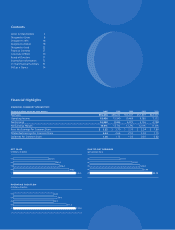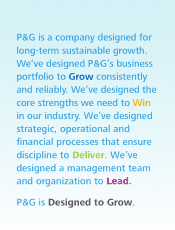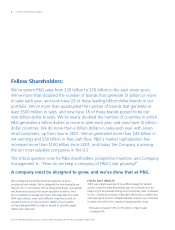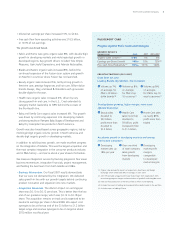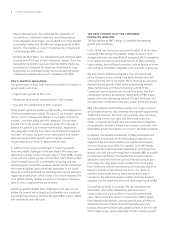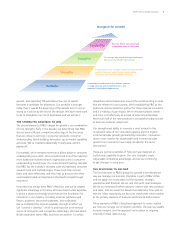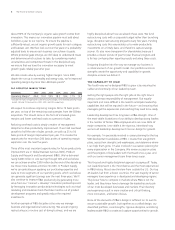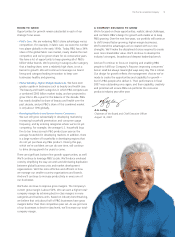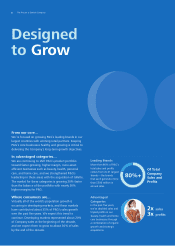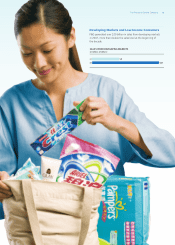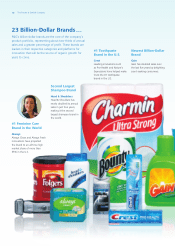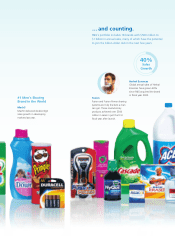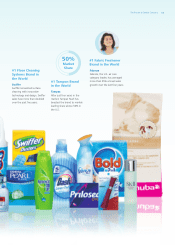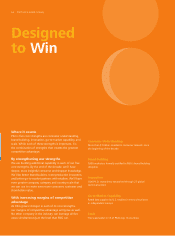Proctor and Gamble 2007 Annual Report Download - page 6
Download and view the complete annual report
Please find page 6 of the 2007 Proctor and Gamble annual report below. You can navigate through the pages in the report by either clicking on the pages listed below, or by using the keyword search tool below to find specific information within the annual report.• Project Management. We completed the integration of
our sales force, distribution networks, and billing systems.
Since integration work began, we’ve added more than 50,000
new product codes and 100,000 new shipping points to P&G
systems. This enables us to go to market as one company and
to fully leverage P&G’s scale.
• Fielding the Best Team. Our management and employee team
is comprised of the best of both companies. Several of our key
management positions have been lled by Gillette employees,
and retention is ahead of the target we established at close.
Importantly, our employee survey results indicate that Gillette
employees are positive about their integration with P&G.
&
Our performance in scal 2007 meets or exceeds the Company’s
growth goals, which are:
Organic sales growth of 4% to 6%
Diluted net earnings per share growth of 10% or better
Free cash ow productivity of 90% or greater
These growth goals are realistic yet demanding. The categories in
which we compete grow about 3% a year. If we maintain market
shares
—
which is always a challenge in our highly competitive
industry
—
we grow along with the categories. But we need
another 1% to 3% growth to meet our goals. The only way to
achieve this growth is to increase market shares, expand into
new geographic markets, and create new brands and categories.
And then, of course, we have to turn sales growth into double-
digit earnings-per-share growth, which requires consistent
margin expansion of 50 to 75 basis points per year.
In addition to the ongoing challenges of sustaining growth,
there are specic challenges in the year ahead. We expect raw
material and energy costs to increase again in scal 2008, roughly
in line with the impact we saw in scal 2007. We’ll need to offset
these increased costs with a combination of pricing and cost-
savings projects. Competitive pressure will also remain a challenge.
We compete against some of the best companies in the world.
Many have restructured and are spending restructuring savings to
regain lost market share, which makes it even more important for
us to deliver industry-leading innovation and superior consumer
value in every category where we compete.
Sustaining growth despite these challenges is not easy, but we
believe the growth we’re targeting is achievable on a consistent,
sustainable basis because we have designed P&G to grow reliably
and consistently, year after year.
The rst element of P&G’s design is a portfolio that balances
growth and consistency.
In the 1990s, two businesses accounted for 85% of all the value
created by P&G through the decade. Today, we have a much
stronger and more robust portfolio of businesses. We’re competing
in 22 categories that include a balanced mix of faster-growing,
higher-margin, asset-efcient businesses, such as beauty or home
care, and large, foundation categories, such as laundry or baby care.
We also have an attractive geographic mix, with about half
of the Company’s sales coming from North America and half
coming from the rest of the world. We’re focusing on achieving
disproportionate growth in fast-growing developing markets.
These markets have contributed more than a third of the
Company’s top-line growth over the past ve years, and their
contribution has been accelerating. Nearly 40% of P&G’s sales
growth came from developing markets this past scal year, and
we expect the contribution to be even greater in the year ahead.
P&G’s diversied portfolio reduces exposure to single economic
and competitive events, and maximizes future growth opportunities.
Traditional businesses, like fabric care and baby care, are strong
and growing in their own right, and they create scale that
makes our beauty and health care businesses more competitive.
Geographically, our North America home base is rock solid, with
dependable growth that allows us to invest in developing markets.
In addition, the breadth and diversity of P&G’s businesses and
the breadth and diversity of the technological expertise that
supports these businesses enable us to transfer technologies
from one business to another. For example, Crest Whitestrips
was created by combining bleach stabilization technology from
laundry care with lm technology from corporate R&D to provide
in-home teeth whitening. The Swiffer Wet Jet pad combines
absorbent cores from feminine care with exible surface layers
from baby care. Olay Daily Facials combines structured paper
from family care with skin conditioning and mild cleansing from
beauty to provide a mini-facial in the home. Our ability to
combine technologies from so many diverse businesses is
unrivaled in the industry because no other consumer products
company has the scope of science and technology found at P&G.
Our business portfolio is not static. We use operating total
shareholder return (TSR) delivered by each business to
continuously ensure our portfolio is maximizing shareholder
value. TSR is a cash ow return on investment (CFROI) model
that measures sales growth, earnings growth and cash ow to
determine the rate of return that each business earns. Any
business that cannot deliver sales growth at least at the low end
of our target range, upper-single-digit or better operating prot
The Procter & Gamble Company
4


